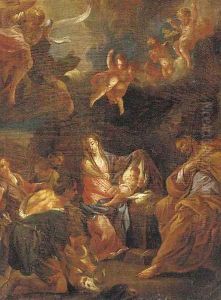Bernardino Cavallino Paintings
Bernardino Cavallino was an Italian Baroque painter who is considered one of the most original and accomplished artists working in Naples during the first half of the 17th century. Born in 1616 in Naples, then part of the Spanish Empire, Cavallino's exact date of birth is not documented, but his baptism was recorded on May 29, 1616. He was purportedly trained by the Neapolitan painter Filippo Vitale, although his early works suggest he was also significantly influenced by the vivid naturalism of Caravaggio and the Bolognese artist Battistello Caracciolo, who was one of Caravaggio's earliest followers in Naples.
Cavallino's oeuvre includes both religious and mythological subjects, characterized by their intimate scale and the tender emotions of the figures. His works are noted for their soft, graceful forms and the use of chiaroscuro—a technique that plays with deep contrasts of light and shadow to achieve a sense of volume in modeling the figures, a method also employed by Caravaggio. Despite his relatively short life, Cavallino was highly prolific, and his paintings are lauded for their elegance and lyrical quality.
His most significant contributions are often considered to be his genre scenes, which were influenced by the works of the Dutch and Flemish artists active in Naples at the time. These works often depicted everyday life with a heightened sense of drama and an empathetic approach to his subjects. Cavallino was also an accomplished draughtsman, and his drawings are highly prized for their beauty and spontaneity.
The artist's career unfolded entirely in Naples, where he enjoyed the patronage of important local collectors and religious institutions. Unfortunately, Cavallino died young, at the age of 40, and his death on January 1656 cut short a promising career. The cause of his death remains unknown. His premature death likely contributed to the subsequent obscurity of his name, as he had no significant followers to perpetuate his style or his fame.
Today, Bernardino Cavallino is recognized for his contribution to Baroque painting in Naples. His works have been collected and exhibited in major museums around the world, and his artistic legacy is appreciated for its emotional depth, technical skill, and the gentle humanity of his portrayals.
